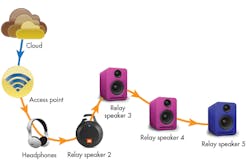This file type includes high-resolution graphics and schematics when applicable.
Electronic Design’s Bill Wong talks with Jawad Haider, senior product marketing manager at Marvell Semiconductor, about the latest wireless audio trends, opportunities, and developments.
Wong: What trends are you seeing in the wireless audio market?
Haider: Wirelessly connected speakers using Bluetooth technology have been around for a few years now. But Bluetooth has its limitations in terms of bandwidth and range. Sonos came in as a trendsetter a few years ago by introducing a Wi-Fi based wireless speaker system using its SonosNet mesh-networking technology. Since then, we have seen Apple AirPlay, Digital Living Network Alliance (DLNA), DTS’s Play-Fi and, most recently, Google Cast protocols emerge with different ways to send audio over Wi-Fi. As there is no one golden standard, a lot of fragmentation exists in the audio ecosystem, which has given consumers many different choices.
The key players driving volume over the next few years will be Amazon, Google, Sonos, Bose, Harman, and Sony, among a few others. Amazon disrupted the market with the introduction of its highly successful Amazon Echo voice-enabled speaker and virtual assistant. Google also recently announced its Google Home device, which acts as a virtual assistant and smart-home control center. The future of the wireless audio market will pivot around these voice-enabled interactive products, which will ultimately free us all from looking at our phone screens all the time!
Another emerging technological trend in this space is “hearables,” which include wireless headsets, headphones, and earbuds using Bluetooth, Bluetooth Low Energy (BLE), and possibly Wi-Fi in the future. With the recent introduction of wireless AirPods by Apple, we will see a huge market building up with Bluetooth- and Wi-Fi-enabled hearables. The key requirements for this market segment will be long battery life and super-low current consumption.
Wong: What are the key technology challenges in delivering wireless audio?
Haider: With the introduction and consumer uptake of multi-channel and multi-room audio, a key challenge is delivering a synchronized audio stream to all of the devices on the network. Precise time-stamping algorithms need to be used on packets entering or leaving the system to ensure that the audio output on speakers is synchronized. Another key factor is the latency between different nodes on the network. As audio OEMs introduce multi-channel systems like 5.1, 7.1, and so on, you need minimum latency introduced between these channels—over the air as well as through the system.
For voice-enabled products, a key challenge is developing the microphone-array design so that the device can accurately listen to users in near-field as well as far-field scenarios. Amazon Echo has done a great job in designing a first-of-its-kind voice-enabled product with excellent voice-listening capability.
For hearables, the key challenge will be to build extremely low-power Wi-Fi and BLE solutions that can sustain music streaming without requiring frequent recharging. One of the techniques that can be deployed will be opportunistically switching between Wi-Fi and BLE, based on range and data-throughput requirements.
Wong: What are the advantages of various wireless audio standards?
Haider: Some of the common wireless audio standards are Bluetooth A2DP, Apple’s AirPlay, Google Cast, Spotify Connect, SonosNet, DTS Play-Fi, DLNA, and Miracast. All of these standards have their own differentiating features and ecosystem plays. Industry leaders have business and technological reasons to push their own ecosystems, which ends up creating fragmentation. However, these various standards continue to remain popular because there’s no one size that fits all.
Bluetooth’s biggest advantage is its ubiquity, as the technology is built into a wide range of devices in the market. Bluetooth is popular for being an easy-to-use, low-power, and low-cost solution. AirPlay, which just works with Apple hardware and software, Google Cast, and Spotify Connect all work over Wi-Fi, enabling a longer distance range for streaming. Play-Fi is another notable protocol for enabling high-resolution audio streaming and the ability to stream audio to multiple speakers at once.
Wong: How is the industry advancing to deliver next-generation wireless audio?
Haider: One of the key trends for next-generation wireless audio is multi-channel and multi-room audio for speakers and sound bars. Consumers want to be able to sync audio seamlessly across different devices and rooms, without range limitations.
One innovative way to enable multi-room audio is through multi-hop relay technology, which extends wireless coverage by linking and sharing audio in a daisy-chain topology. Since accurate time-stamping is also critical for seamless multi-channel and multi-room audio synchronization, the industry is adopting the IEEE 802.11mc standard to deliver synchronization accuracy in microseconds.
Wong: What are some new applications for wireless audio technology?
Haider: The wireless audio market is growing at a significant pace, expected to reach $54.07 billion by 2022 at a CAGR of 23.2% between 2016 and 2022, according to MarketsandMarkets. The introduction of voice-assisted products, such as Amazon Echo and Google Home, will prove to be one of the most disruptive innovations in the wireless audio segment. All tier-one audio OEMs will introduce an audio-streaming device with voice capability in the near future, with a lot of integration—think of all of your favorite applications like maps, Gmail, Hangouts, Uber, Amazon.com, WhatsApp, YouTube—all readily available through voice interaction while sitting at your couch.
We’re also starting to see more ultra-low-power wireless and Bluetooth/BLE solutions on the market, enabling connected devices to last even longer on the go with an extended battery life and better throughput and range for high-resolution wireless audio. According to market research firm WiFore, the volume forecast for this segment will surpass 120Mu in 2020, dominated by wireless headsets and earbuds.
Wong: Can you tell me about Marvell’s wireless audio solutions?
Haider: Marvell’s wireless solutions provide high-performance and low-power connectivity for many of the most popular audio products on the market today. Marvell’s newest Avastar wireless connectivity combos incorporate dynamic multi-hop relay (DMHR) technology to connect up to 15 devices in a daisy-chain fashion. Combining a core Wi-Fi technology developed by Marvell and application stack, and system-level intelligence and synchronization algorithms developed by our partners, the Avastar solutions extend the range of traditional Wi-Fi networks 15 times from 40 m to almost 600 m in a typical home—a true game changer for many home and enterprise audio applications.
We’ve also enabled new features such as connecting up to 31 clients to your speaker or sound bar, which acts as a soft access point. In addition, our new chipsets have support for the new IEEE 802.11mc standard to support applications in highly synchronized audio solutions.
About the Author
William G. Wong
Senior Content Director - Electronic Design and Microwaves & RF
I am Editor of Electronic Design focusing on embedded, software, and systems. As Senior Content Director, I also manage Microwaves & RF and I work with a great team of editors to provide engineers, programmers, developers and technical managers with interesting and useful articles and videos on a regular basis. Check out our free newsletters to see the latest content.
You can send press releases for new products for possible coverage on the website. I am also interested in receiving contributed articles for publishing on our website. Use our template and send to me along with a signed release form.
Check out my blog, AltEmbedded on Electronic Design, as well as his latest articles on this site that are listed below.
You can visit my social media via these links:
- AltEmbedded on Electronic Design
- Bill Wong on Facebook
- @AltEmbedded on Twitter
- Bill Wong on LinkedIn
I earned a Bachelor of Electrical Engineering at the Georgia Institute of Technology and a Masters in Computer Science from Rutgers University. I still do a bit of programming using everything from C and C++ to Rust and Ada/SPARK. I do a bit of PHP programming for Drupal websites. I have posted a few Drupal modules.
I still get a hand on software and electronic hardware. Some of this can be found on our Kit Close-Up video series. You can also see me on many of our TechXchange Talk videos. I am interested in a range of projects from robotics to artificial intelligence.






